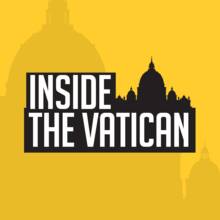The synod delegates have returned home and the round tables have been put away. Now, a month after the first Roman meeting of the Synod on Synodality, many Catholics are left wondering: What just happened?
This deep dive episode of “Inside the Vatican” explains the key events and dynamics of the synod, combining recordings from synod events with a diverse selection of interviews, inviting you to “listen in” on this historic meeting.
Host Colleen Dulle explains how exactly the synod’s “Conversation in the Spirit” method worked and speaks with several synod participants about how those conversations came to be transformative.
“First, I thought it was pious nonsense to ‘talk in the spirit.' I said, this is going to be a blessed headache,” recalled Vimal Tirimanna, C.Ss.R., a moral theologian from Sri Lanka who collaborated with the synod secretariat in every stage of the synodal process. “These round tables have challenged me a lot.”
Vimal Tirimanna, C.Ss.R.: “These round tables have challenged me a lot.”
“It became a discipline, dear Colleen, in my life. I’m trying now, even in my classes, here in my lectures, in my way of doing things…to follow that method, to listen,” Father Tirimanna added.
The episode digs into the tensions at the synod, both around contentious topics in the synod hall and in the Vatican’s daily press conferences.
It also gives an overview of the synod’s final document and the frantic final days in which the document was drafted and approved.
“It’s a miracle because, within 48 to 72 hours, they produced it,” after receiving 1,000 amendments to the first draft, Father Tirimanna said.
Bishop Bill McGrattan of Calgary, president of the Canadian Conference of Catholic Bishops, reflects on the final document’s section on bishops, which called for greater responsibilities for lay people and suggested a new process for reviewing each bishop’s ministry.
One open question that emerged was whether there should be a return to a bishops-only synod following a “synodal assembly” that includes lay people. Bishop McGrattan said, “I really do think that this is an area that needs further clarification. Are we going to go forward with a synodal assembly representing the church? Are we going to have that in relationship to the Synod of Bishops knowing that collegiality is a very important theological reality in the role of the bishops?”
And ecclesiologist Catherine Clifford speaks with Colleen about how the synod is reshaping the church and its structures by teaching its members to listen to one another.
“The first thing we should expect to see is a whole lot of work and reflection about structures and practices of church governance,” Dr. Clifford said. “Those kinds of changes don’t happen overnight.”
Interviews in this episode include:
- Vimal Tirimanna, C.Ss.R., a synod theologian and moral theologian from Sri Lanka
- Dr. Catherine Clifford, an ecclesiologist and full voting member of the synod
- Bishop Bill McGrattan, president of the Canadian bishops’ conference and a synod member
- John Thavis, former Rome bureau chief of Catholic News Service
- Olivier Poquillon, O.P., a member of the synod’s methodology commission and rector of the École Biblique in Jerusalem
Links from the show:
- What our editors learned while reporting on the Synod on Synodality from Rome
- Sam Sawyer, S.J.: At the synod in Rome: Waiting to find out where to go
- 15 hidden gems in the Synod report that could lead to major church reforms
- Father James Martin: What happened at the Synod on Synodality
- Explore all of America’s coverage of the Synod on Synodality







